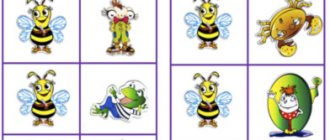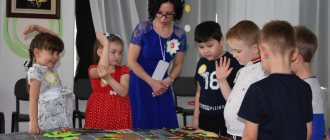Games and toys for kids
Contained in sections:
- Didactic games 31952
- Sensory development and education. Sensory 6509
Includes sections:
- Didactic and sensory aprons and skirts 100
- Smell. Games, manuals “Recognize by smell” 9
- Velcro games 98
- Keyboard games 12
- Games with rubber bands 63
- Flashlight games 31
- Palms. Games, teaching aids 49
- Marbles. Games with pebbles 182
- Couple, pick a couple, couple pictures 277
- Pick up a patch. Games, teaching aids 65
- Clothespins. Games with clothespins for children 485
- Tactile development of children. Games and aids 436
- Color, learning colors. Games, teaching aids 1492
- Laces. DIY games with laces 167
- Noise boxes. Games, teaching aids 24
By groups:
- Junior group
Showing publications 1-10 of 1198. All sections | Sensory games
New
Photo
The best
Sensory simulator for working with children with speech impairments
Sensory simulator for working with children with speech impairments. " Sensory canvas "
for the development of manual motor skills, it is a canvas made of fabric onto which bags are attached using buttons. These bags come in different sizes: four small and four large. Each bag...
Card index of didactic games on sensory education for children of primary preschool age Prepared by: teacher of MBDOU kindergarten No. 32 Bykova A.V. sensory development is the development of his perception and the formation of ideas about the external properties of objects: their shape, color, size, position in space, as well as smell and taste. The importance of sensory development in...
Game as a method of teaching and education in kindergarten.
Children's play is a means of actively enriching the personality, since it represents a free choice of various socially significant roles and positions, and provides the child with activities that develop his unlimited capabilities and talents in the most appropriate use.A game is a type of unproductive activity, the motive of which lies in the process itself, and the goal is to obtain satisfaction from the player.
The game can be understood in different ways:
— game is a special type of human activity;
- the game is a means of influencing the players (since it is specially organized and has a specific goal);
-game - a special set of rules that require their execution;
-game is a special way of conditionally appropriating the world;
-game- as a form of pedagogical activity.
Any game can implement the entire range of the following functions:
1. emotionally developing function;
2. diagnostic function - hidden talents are revealed;
3. relaxation function - excessive tension is reduced;
4. compensatory function - gives a person what he lacks;
5. communicative function - is an excellent means of communication;
6. function of self-realization - serves as a means to achieve desires and realize opportunities;
7. sociocultural function - during the game a person masters sociocultural norms and rules of behavior;
8. therapeutic function - can serve as a means of treating human mental disorders.
Organizing a high-quality, useful game is a complex and painstaking process. The teacher must master this art (precisely formulate the rules, organize the space, choose the appropriate time, determine the plot of the game, select the game props and competently organize the beginning and ending) When organizing the game, he must choose one or two functions as the main goal that will be him the most important.
The role of play in education in kindergarten
When starting to organize play in kindergarten, educators rely on the already achieved level of development of the children, their inclinations, habits, abilities, and then systematically rebuild the existing interests of the children into the desired ones, increasing the requirements for them, patiently and persistently working on their spiritual growth.
It is important for kindergarten teachers to rely on the role of play in education. But they should not equate play in a child only with entertainment. Let some games be fun entertainment, and others a favorite pastime during leisure hours. It’s good if no one is bored, everyone is busy with something, an interesting game. But not only this determines the inextricable connection between play and the entire process of education. Much depends on the methodology and technique of their organization, on the style of play, and most importantly on its quality. Only in this way can the role of play in education be realized.
The role of play in education is that it is in games that children reveal their positive and negative qualities and the teacher gets full opportunity to properly influence everyone together and each individual.
If the games really captivate the children, then the teacher also has at his disposal the necessary punitive measures, up to and including expelling children from the game for violating the rules or for bad behavior.
Despite the great role of play in education, it cannot be isolated, considered a mono-means, or expected to educate children through games alone.
The role of play in instilling the right attitude towards work is great. Very often it is possible to combine a game so successfully with the labor process that it will decorate the work, cultivate a constant love for it, and help to successfully master the skill.
The educational role of the game is that games teach children to live and work in a team, to take into account the interests of their comrades, to come to their rescue, to follow established rules, and to fulfill the requirements of discipline.
When planning work for the school year, educators set themselves goals and objectives through which they will develop the creative abilities of students, the physical capabilities of children, and help create a friendly children's team, i.e. make the most of the role of play in education. That is why games in all their diversity are widely used in educational work with children.
Most psychologists and teachers consider play in preschool age as an activity that determines the child’s mental development, as a leading activity, during which mental new formations arise.
Play is the most accessible type of activity for children; it is a way of processing impressions and knowledge received from the surrounding world. Already in early childhood, a child has the greatest opportunity in play, and not in any other activity, to be independent, to communicate with peers at his own discretion, to choose toys and use different objects, to overcome certain difficulties logically related to the plot of the game, its rules.
The goal of play therapy is not to change the child or remake him, not to teach him any special behavioral skills, but to give him the opportunity to “live” situations that excite him in the game with the full attention and empathy of an adult.
Using gaming technologies in the educational process, an adult needs to have empathy, goodwill, be able to provide emotional support, create a joyful environment, encourage any invention and fantasy of the child. Only in this case will the game be useful for the development of the child and the creation of a positive atmosphere of cooperation with adults.
At first they are used as separate game moments. Game moments are very important in the pedagogical process, especially during the period of adaptation of children in a child care institution. Starting from two to three years old, their main task is the formation of emotional contact, children’s trust in the teacher, the ability to see in the teacher a kind person, always ready to help (like a mother), an interesting partner in the game. The first play situations should be frontal, so that no child feels deprived of attention. These are games like “Round Dance”, “Catch-Up” and “Blowing Soap Bubbles”.
In the future, an important feature of gaming technologies that educators use in their work is that gaming moments penetrate into all types of children’s activities: work and play, educational activities and play, everyday household activities related to the implementation of the regime and play.
Role-playing game is one of the creative games. In role-playing games, children take on certain functions of adults and, in playful, imaginary conditions specially created by them, reproduce (or model) the activities of adults and the relationships between them. In such a game, all the mental qualities and personality traits of the child are most intensively formed.
Children's independence in role-playing games is one of its characteristic features. Children themselves determine the theme of the game, determine the lines of its development, decide how they will reveal the roles, where the game will unfold. Uniting in a role-playing game, children choose partners of their own free will, set the game rules themselves, monitor implementation, and regulate relationships. But the most important thing in the game is the child embodying his view, his ideas, his attitude towards the event that he is acting out.
The main component of a role-playing game is the plot, which is the child’s reflection of certain actions, events, relationships from the life and activities of others. At the same time, his game actions (cooking dinner, turning the steering wheel of a car, etc.) are one of the main means of realizing the plot.
The plots of the games are varied. They are conventionally divided into:
1. Household (family games, kindergarten)
2. Production, reflecting the professional work of people (hospital, store, hairdresser)
3. Public (Birthday, library, school, flight to the moon)
The content of the role-playing game is embodied by the child through the role he takes on. A role is a means of realizing the plot and the main component of a role-playing game.
Directing play is a type of creative play. It is close to the role-playing game, but differs from it in that the characters in it are not other people (adults or peers, but toys depicting various characters. The child himself gives roles to these toys, as if animating them, he himself speaks for them different voices and he himself acts for them. Dolls, teddy bears, bunnies or soldiers become the protagonists of the child’s game, and he himself acts as a director, managing and directing the actions of his “actors”, which is why such a game is called directorial.
The integrated use of gaming technologies for different purposes helps prepare a child for school. From the point of view of the formation of motivational and emotional-volitional readiness for school, each play situation of communication between a preschooler and adults, with other children is for the child a “school of cooperation”, in which he learns to both rejoice in the success of a peer and calmly endure his own failures; regulate their behavior in accordance with social requirements, and equally successfully organize subgroup and group forms of cooperation. The problems of developing intellectual readiness for school are solved by games aimed at developing mental processes, as well as special games that develop elementary mathematical concepts in a child, introduce him to the sound analysis of words, and prepare his hand for mastering writing.
Thus, gaming technologies are closely related to all aspects of the educational work of a kindergarten and the solution of its main tasks. However, there is an aspect of their use that is aimed at improving the quality of the pedagogical process by solving situational problems that arise during its implementation. Thanks to this, gaming technologies turn out to be one of the mechanisms for regulating the quality of education in kindergarten: they can be used to level out negative factors that influence the decrease in its effectiveness. If children are systematically engaged in play therapy, they acquire the ability to manage their behavior, tolerate prohibitions more easily, become more flexible in communication and less shy, cooperate more easily, express anger more “decently,” and get rid of fear. Their play activities begin to be dominated by role-playing games depicting people’s relationships. Folk games with dolls, nursery rhymes, round dances, and joke games are used as one of the effective types of game therapy. Using folk games in the pedagogical process, educators not only implement the educational and developmental functions of gaming technologies, but also various educational functions: they simultaneously introduce students to folk culture. This is an important area of the regional component of the kindergarten educational program, which is still insufficiently developed.
In theatrical games (dramatization games), the actors are the children themselves, who take on the roles of literary or fairy-tale characters. Children do not invent the script and plot of such a game themselves, but borrow it from fairy tales, stories, films or plays. The task of such a game is to, without deviating from the well-known plot, reproduce the role of the character assumed as accurately as possible. The heroes of literary works become characters, and their adventures, life events, and changes by children’s imagination become the plot of the game.
The peculiarity of theatrical games is that they have a ready-made plot, which means the child’s activity is largely predetermined by the text of the work. Theatrical play is a rich field for children's creativity. Creative role-playing in a theatrical play is significantly different from creativity in a role-playing game. In role-playing games, the child is free to convey the image of role-playing behavior. In a theatrical play, the image of the hero, his main features, actions, and experiences are determined by the content of the work. The child's creativity is manifested in the truthful portrayal of the character. To implement it, the child must understand what the character is like, why he acts this way, and imagine his state and feelings. To play the role, the child must master a variety of visual means (facial expressions, body movements, gestures, expressive and intonation speech). Theatrical and play activities enrich children in general with new impressions, knowledge, skills, develop interest in literature and theater, form dialogical, emotionally rich speech, activate the vocabulary, and contribute to the moral and aesthetic education of each child.
Thus, the phenomenon of play should be treated as a unique phenomenon of childhood. Play is not only an imitation of life, it is a very serious activity that allows a child to assert himself and realize himself. By participating in various games, the child chooses characters that are closest to him and correspond to his moral values and social attitudes. The game becomes a factor in the social development of the individual
Conclusion
So, play occupies an important place in the organization of children’s lives. Games are repeated daily, and on “their shoulders”, in favorable conditions, the children’s team grows and strengthens, with its inherent diversity of interests, the joy of communication, and social life skills. The games clearly show the level of social education, moral qualities, social behavior skills of children, and the level of their interests.
The process of play in preschoolers requires the involvement of the teacher, but with different goals, at different levels of development of relations between children. When a teacher enters the center of a child’s life - the circle of relationships that develop between children, then it is easy for him to navigate the organization of the game. From this follows the conclusion that it is necessary to master the skill of managing the game to such an extent that you are ready at any moment to show the children the game, play it with them, evaluate their achievements in mastering the rules and the still small but still existing technique of the game. For a child, mastering a new game means gaining new experiences. When the children master the game, then we will say: “Now you already know how to play yourself.” The more contact he has with children, the more often an adult acts as a connoisseur and advisor. The assessment should be made in a friendly manner, avoiding the tone of instruction or order.
We take the game as the life of children with all the contradictions, feelings, experiences, actions it contains, in general, with manifestations of an integral human personality. If for a child play is true life, then by organizing this life well and wisely we get great opportunities in raising children.
LIST OF REFERENCES USED
1. Azarov YL. Play and work. - M., 1973. Azarov YL. The art of education. - M., 1979.
2. Anikeeva N.P. Education by playing. - M., 1987.
3. Gazman O.S. etc. To school - with a game. - M., 1991.
4. Guruzhapov VA. Questions of examination of educational technologies // Psychological science and education. 1997. No. 2.
5. Zanko S.F. et al. Game and learning. - M., 1992.
6. Zimnyaya A. N. Pedagogical psychology - M., 2000.
7. Games - education, training, leisure... / Ed. V.V. Letrusinsky. - M., 1994.
8. Ilyina TA. Pedagogy. - M., 1984.
9. Clarin M.V. Pedagogical technology. - M., 1989.
10. Likhachev B.T. Pedagogy. - M., 1992.
11. Minkin E. M. From game to knowledge. - M., 1983.
12. Nikitin B.P. Steps of creativity, or educational games. - M, 1990.
13. Pedagogy / Ed. Yu.K. Babansky. - M., 1983.
14. Pedagogical creativity at school (from the experience of Russian teachers) / Ed. V.F. Krivosheeva - M., publishing house of the Scientific Research Institute of Schools of the RSFSR Ministry of Defense, 1992. - 114 p.
15. Samukina N.V. Organizational and educational games in education. - M.: Public Education, 1996.
16. Stolyarenko V.A. Educational psychology - Mn. ,2000.
17. Yakovlev N.M., Sokhor A.M. Lesson methods and techniques at school. - M., 1985. - 163 p.
18. Yanovskaya. M.G. Creative play in educating primary schoolchildren. - M., 1974.
Sensory games - Multifunctional didactic manual for children on sensory development
Publication “Multifunctional didactic manual for children on sensory…”
Multifunctional didactic manual for children of primary preschool age on sensory development. The manual helps the development of fine motor skills in children, the formation of sensory standards of color, shape, and size. It contains a selection of various types of didactic developments. On the…
Image library "MAAM-pictures"
Didactic game for sensory development of children 4–5 years old “House”
Goal: To become familiar with the characteristic features of successive seasons. To form ideas about the simplest interactions in living and non-living nature. Familiarity with the rules of behavior in nature (do not take plants unnecessarily, do not break tree branches, etc....
Card index of games for the sensory development of young children Games for the development of tactile sensations: “Magic bag”. The child examines and places toys or objects in the bag in advance. Then he determines by touch what kind of toy it is and names it. "Find a match." An adult shows the child an object. The child must find in the bag...
Multifunctional teaching aid made from plastic gratings for the sink “Sensory Cube”
“SENSOR CUBE” Multifunctional teaching aid. The “Sensory Cube” is easy to make, multifunctional, takes up little space, and can be used both individually and in a group. There are many exercises and games that can be used with this manual. U...






